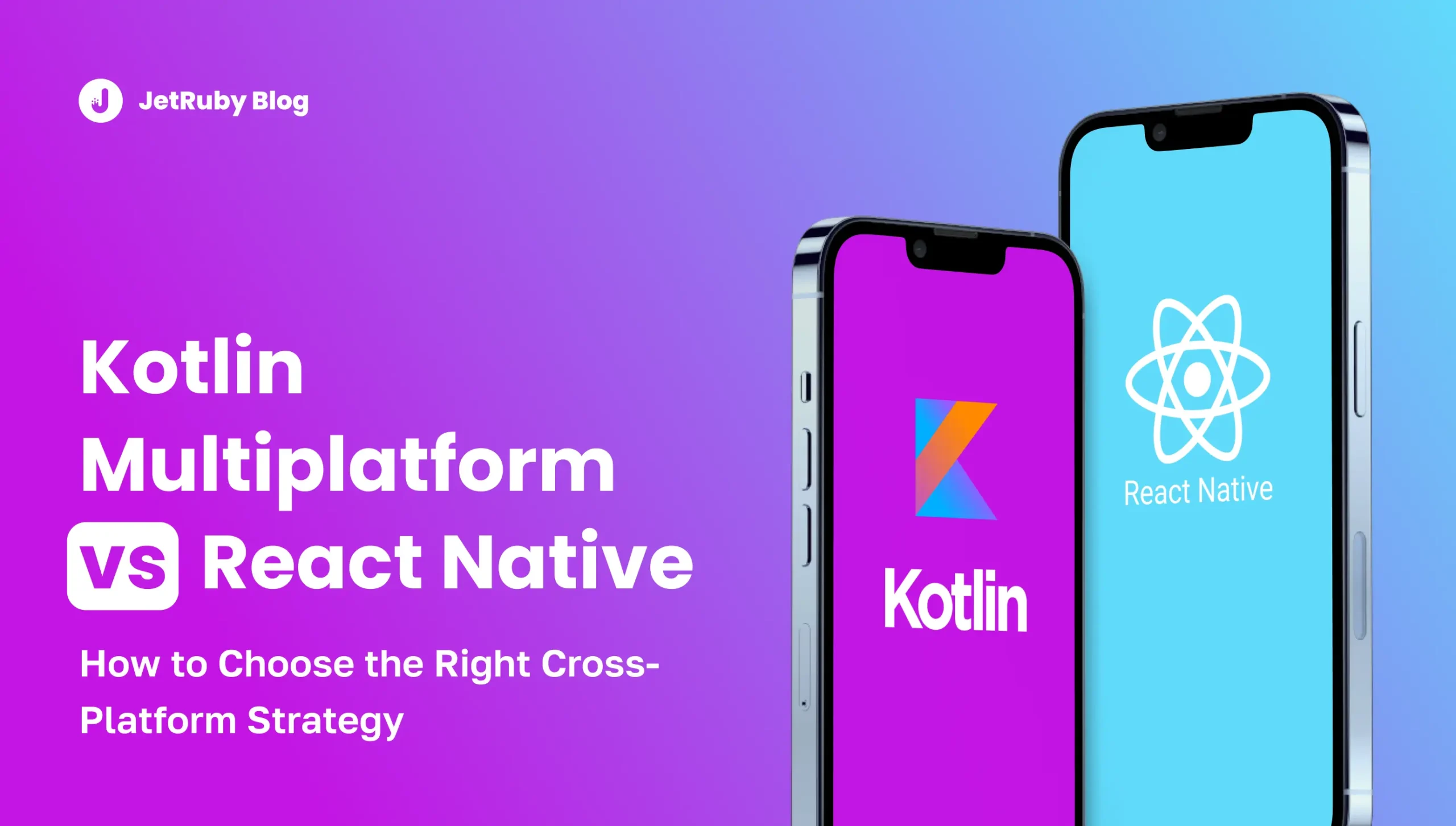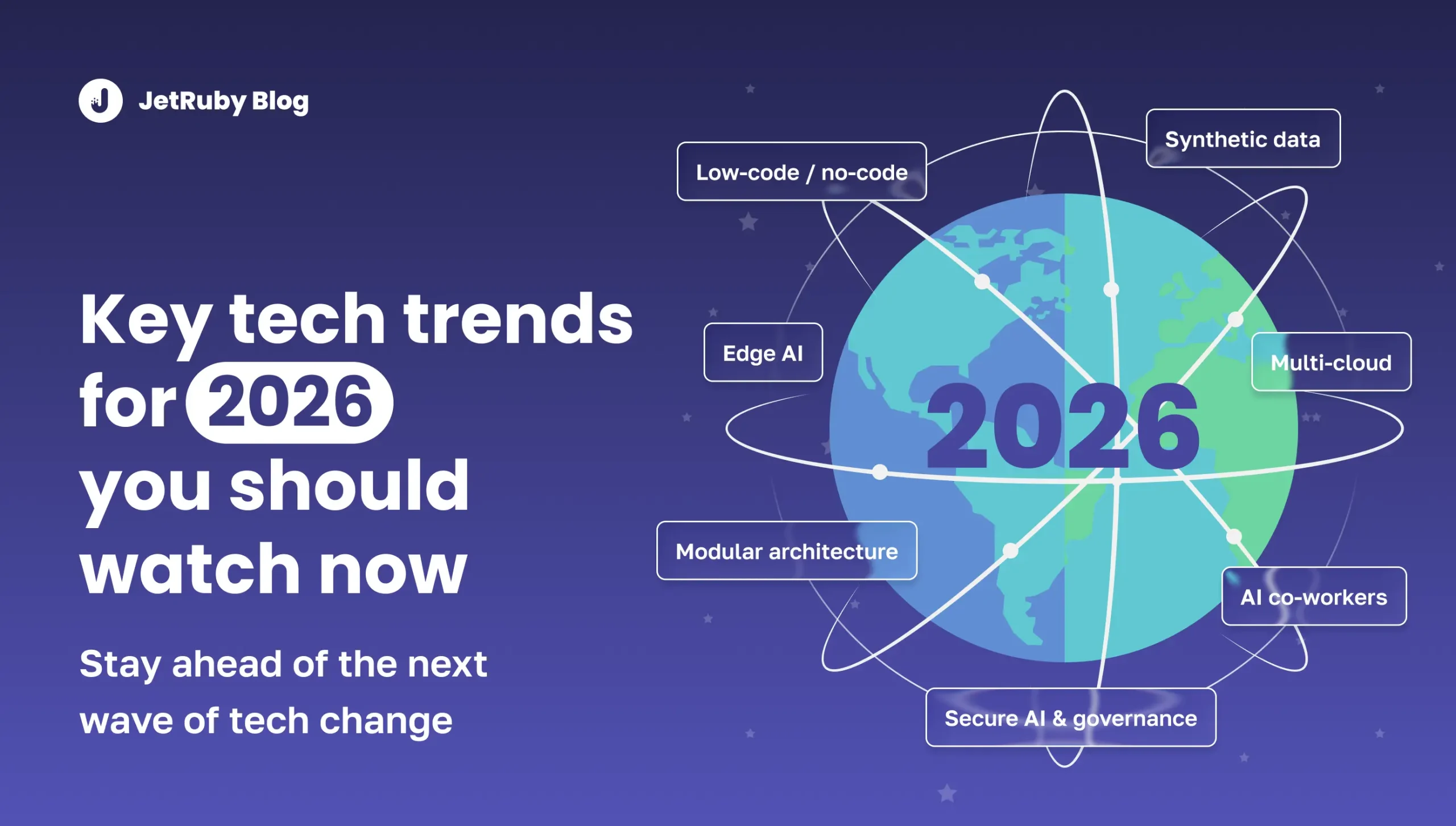Table of Contents
Cross-platform development has come a long way since the early “write once, run anywhere” promises. In 2025, companies are looking for a balance between speed, performance, and maintainability, and two leading technologies stand out: Kotlin Multiplatform (KMP) and React Native.
At Jetruby, we’ve helped startups and enterprises build production apps using both approaches. Each has distinct strengths, trade-offs, and ideal use-cases. Here’s how they truly compare, and how global brands are leveraging them today.
The Real Question Behind the Choice
Most teams don’t ask, “Which is better?”. They ask, “Which one will deliver the most value with the least friction?”
React Native and Kotlin Multiplatform tackle that question from opposite sides:
- React Native shares both UI and business logic, enabling rapid delivery from a single JavaScript/TypeScript codebase.
- Kotlin Multiplatform focuses on sharing core logic: networking, data, and domain layers, while keeping UI native or partially shared via Compose Multiplatform.
Both are powerful, but they serve different strategies.
Cost Comparison: How Much Does Development Actually Cost?
Before we go deeper, here’s what most founders and CTOs really want to understand: the financial impact.
While exact numbers vary by region and app complexity, global averages look like this:
React Native Cost Ranges
- MVP / simple consumer app: $35,000–$80,000
- Mid-level product (market-ready app): $80,000–$180,000
- Complex app with custom UI, animations, or multiple integrations: $150,000–$300,000
- Enterprise-grade systems: $250,000+
Why is it generally cheaper?
React Native lets teams reuse 70-90% of their codebase, including UI, significantly reducing development hours.
Kotlin Multiplatform Cost Ranges
- MVP sharing only core logic: $50,000-$110,000
- Full production app: $120,000-$250,000
- Enterprise products with domain-heavy logic: $200,000-$400,000+
Why is it usually higher?
KMP shares logic but preserves native UI. This often requires two UI teams, although the shared architecture significantly reduces long-term costs.
However, KMP can reduce backend/core logic duplication by 40-60%, which saves substantial money over the project’s lifecycle (1-3 years).
Core Differences that Matter
Performance and Overhead
React Native offers smooth performance for most consumer apps. However, because it relies on a JavaScript-to-native bridge, very complex animations or computationally intensive tasks can run into limits.
It also sometimes struggles to integrate with specific native visual components fully and has limited access to some system-level modules, which can cause issues for products that depend on advanced navigation features or built-in operating system security mechanisms.
Kotlin Multiplatform runs closer to the metal. Shared logic compiles directly to native binaries, eliminating the JS bridge and achieving near-native performance, especially for data-intensive or real-time features.
Case in point:
When Baidu built its Wonder app using Kotlin Multiplatform, it unified data and domain logic across Android and iOS while keeping native UIs. The result was: consistent behavior, faster maintenance, and native-level responsiveness.
Startup Time and Memory
React Native initializes a JS engine at startup, which can slightly delay app launch. Kotlin Multiplatform apps, especially on Android, compile ahead of time, making them lighter and faster to start.
This difference may seem small, but when scaled to millions of daily sessions, it results in a noticeable improvement in user experience.
Developer Experience and Hot Reload
React Native shines here. Its hot reload and fast refresh features let developers tweak the UI in real time, massively accelerating iteration cycles.
However, development is often carried out by teams familiar primarily with React Native – many of whom come from a web or frontend background rather than native mobile development. This can lead to challenges when native code needs to be written (which is occasionally necessary) or during the app store submission process, as each platform has its own intricate requirements and quirks.
KMP, while powerful under the hood, doesn’t yet offer this instant feedback for the UI. Developers still rebuild per platform when adjusting visuals. The trade-off? Type safety, compile-time guarantees, and more predictable performance in production.
Code Sharing and Architecture
React Native’s “one codebase for everything” approach simplifies smaller projects and MVPs. Kontlin Multiplatform. By contrast, shares logic but preserves platform-specific UIs. But MVPs either die or become working applications in the blink of an eye, and early users provide feedback immediately. Hence, the developments made in the MVP form the foundation of the entire application. This means that if the hypothesis is proven and there is market fit, Kotlin Multiplatform is the right choice if you don’t want to rewrite everything from scratch.
Example:
Cash App used Kotlin Multiplatform Mobile to share business logic across Android and iOS while maintaining native UIs, reducing code duplication, and improving consistency between platforms.
Ecosystem and Community Support
React Native has a massive ecosystem that includes countless open-source packages, active forums, and enterprise adoption from Meta, Shopify, and others.
However, the growth of this ecosystem has significantly slowed in recent years, mainly due to challenges with deep integration into operating system functionality. Despite its size, not all popular libraries are actively maintained — updates and vulnerability fixes are inconsistent across the ecosystem.
Kotlin Multiplatform’s ecosystem is newer but rapidly growing. JetBrains’ investment in tooling and Compose Multiplatform is accelerating adoption fast. For teams already fluent in Kotlin or Android development, the transition is now smoother than ever.
Type Safety and Maintainability
TypeScript improves React Native’s developer experience, but it still can’t match Kotlin’s compile-time rigor.
KMP offers strict type safety, null handling, and early error detection, making it especially appealing for large, long-term projects. Enterprises that value predictability and stability often gravitate toward this model.
Real-World Case Studies
Let’s look at how organizations have put these technologies to work.
Kotlin Multiplatform in Action
- Baidu (Wonder App): Unified data, caching, and API logic across platforms with KMP. Maintained native UIs while reducing code duplication by 30-40%.
- Cash App: Shared business logic across Android and iOS using KMM while keeping native UIs. This reduced code duplication and improved consistency between platforms.
React Native in Action
- Global Lifestyle Brand: Rebuilt their e-commerce app in React Native, improving app speed and user flow. Cart abandonment dropped from 85% to 42%, conversions doubled, and app store rating rose from 2.1 ★ to 4.8 ★.
- Callstack Enterprise Clients: Used React Native to deploy a single codebase across 5 TV platforms (Tizen, FireTV, tvOS, etc.). Startup time improved 5%, re-renders cut by one-third, and maintenance costs decreased.
These examples highlight a clear pattern:
- React Native accelerates UI-centric consumer apps and MVPs.
- KMP excels in logic-heavy or enterprise contexts demanding reliability and performance.
The Decision Framework
So, how do you actually decide between Kotlin Multiplatform and React Native? It comes down to your team’s strengths, project goals, and long-term priorities.
Here’s a quick guide to help you frame the decision.
If your goal is to:
- Get to market fast and reuse both UI and logic across platforms — go with React Native. It’s well-suited for quick concept prototypes and small showcase apps aimed at investors, but even for MVPs, it’s often better to consider more modern approaches.
- Achieve native-level performance and benefit from strict typing, compile-time checks, and predictable behavior — choose Kotlin Multiplatform.
- Leverage existing JavaScript or web talent — stick with React Native, since it’s built on familiar web technologies, but be ready to bring in native developers for app publishing and for writing modules that require native code.
- Capitalize on existing Kotlin or Android expertise — opt for Kotlin Multiplatform, which extends Kotlin’s strengths to iOS and other platforms.
- Plan for long-term scalability and full code ownership — Kotlin Multiplatform offers a stronger architectural foundation and better maintainability over time.
- Validate ideas quickly or build an MVP — React Native is still the fastest way to ship and test a cross-platform concept.
In short:
React Native is about speed and reach.
Kotlin Multiplatform is about stability and scalability.
The best choice depends on your team’s DNA: what skills you already have, how fast you need to move, and how much you value long-term maintainability over short-term velocity.
How Jetruby Helps Companies Choose the Right Stack
At Jetruby, we don’t believe in one-size-fits-all solutions. We evaluate your product goals, team composition, and scalability needs before recommending a tech stack.
Our approach:
- Audit your existing mobile or web setup
- Prototype with both React Native and Kotlin Multiplatform if needed
- Validate performance, maintainability, and ROI before full investment
Whether you’re building your first MVP or scaling a cross-platform enterprise app, we’ll help you pick the right stack, based on data, not hype.
Why is Jetruby the Right Partner for This Decision?
We’re not just developers. We are architects who build solutions to last for years to come. Our process includes:
- Deep analysis of your existing codebase and team structure. We assess how easily your developers can adapt to the chosen technology.
- Prototyping and benchmarking. We can build two prototypes of a key screen so you can visually compare performance and development speed.
- Creating a migration roadmap. If you already have an existing application, we’ll show you how to gradually implement KMP or RN without disrupting ongoing development.
Ready to Make the Right Choice?
If you’re evaluating cross-platform options or planning to modernize your mobile architecture, reach out to Jetruby’s product strategy team.
We’ll help you find the balance between speed, performance, and maintainability, so you can deliver the experience your users deserve.
Get a free technical audit from Jetruby.



